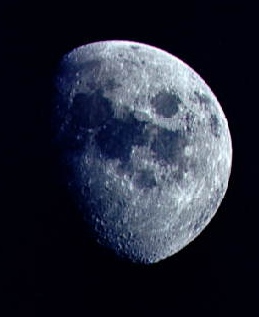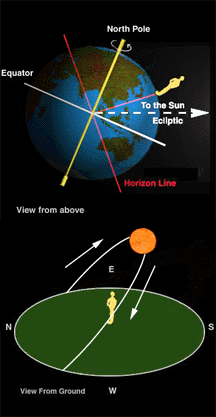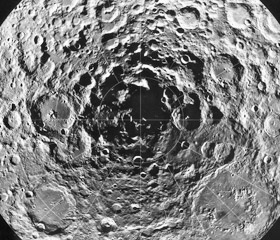This picture shows the Moon's South Pole. Some areas near the pole are in dark shadows all of the time. There might be water ice in some of those shady places.
Click on image for full size
Image courtesy NASA.
The Moon's Poles
The North and South Pole of the Moon are interesting places. Some areas near the Moon's poles are almost always in sunlight. Other places near the poles are always in dark shadows.
Earth is tilted on its axis by 23°. This tilt causes our seasons. During summer it is always light near the pole, but in the winter it is dark all the time. The Moon is hardly tilted at all (less than 2°), so it doesn't have seasons. Places near the Moon's poles are always on the edge between day and night.
High mountains near the Moon's poles might get sunlight almost all of the time. That would be a great place for explorers to build solar panels. The panels would make electricity almost all of the time, since they would almost always be in sunlight. There are peaks near the North Pole and near the South Pole on the Moon that are probably lit nearly all of the time.
There are also some really dark, cold places near the Moon's poles. The bottoms of some deep craters may be in dark shadows all of the time. That would make them very cold, since they wouldn't be heated by sunlight. There might even be water ice in some of those dark craters. Ice could tell us a lot about the Moon's history. It could also be used by astronauts as drinking water, to make oxygen to breath, and to create rocket fuel.
You might also be interested in:

How did life evolve on Earth? The answer to this question can help us understand our past and prepare for our future. Although evolution provides credible and reliable answers, polls show that many people turn away from science, seeking other explanations with which they are more comfortable.
...more
The Earth's one natural satellite, the Moon, is more than one quarter the size of Earth itself (3,474 km diameter). Because of its smaller size, the Moon's gravity is one-sixth of the Earth's gravity,
...more
The Earth is rotating around an axis (called its rotational axis). Some objects rotate about a horizontal axis, like a rolling log. Some objects, such as a skater, rotate about a vertical axis. The Earth's
...more
During the year, the seasons change depending on the amount of sunlight reaching the Earth as it revolves around the Sun. The seasons are caused as the Earth, tilted on its axis, travels in a loop around
...more
Let's pretend, for the moment, that you're the person standing on the Earth in the picture to the left, living in Topeka, Kansas, around 40° N latitude. The picture on the left shows the view from the
...more
Let's pretend, for the moment, that you're the person standing on the Earth in the picture to the left, living in Topeka, Kansas, around 40° N latitude. The picture on the left shows the view from the
...more
The tiny Lunar Prospector probe launched in January 1998 has found the answer to the most controversial question in lunar science. The Lunar Prospector has found that there is indeed water-ice located
...more
In decades past is was accepted that the Moon contained no water. Moon rocks collected by Apollo astronauts (at lunar equatorial regions) contained no traces of water. Lunar mapping performed by the Galileo
...more















